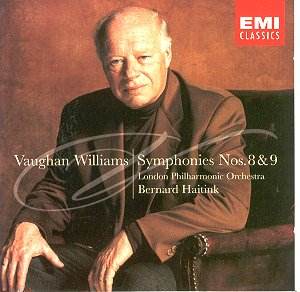Ralph VAUGHAN
WILLIAMS
Symphonies 8 and 9
 LPO/Haitink
LPO/Haitink
 EMI 7243 5 57086 2 5
EMI 7243 5 57086 2 5
Crotchet
AmazonUK AmazonUS

Bernard Haitink takes a serious view of the last two Vaughan Williams symphonies,
challenging received opinion in the case of the Eighth (1955) which is
occasionally regarded with a patronising "little Eighth" attitude that used
to adhere to Beethoven's no 8. In Haitink's hands, the opening Variations
"in search of a theme" are cogently argued, the Andante non troppo
variation being especially deeply felt (6' 22''). The vibraphone is used
with discretion, thus helping to take the symphony out of the mid-50s kitsch
in which it can sometimes seem mired. The woodwind-only scherzo is rather
a poker-faced joke but the seriousness of purpose is at one with Haitink's
overall conception. The Cavatina for strings is beautifully played,
ghosts of the Tallis Fantasia and The Lark
Ascending recalled in a resigned, not complacent tranquillity. The
'spiels and 'phones are not allowed to dominate the first subject's bluff
joviality in the Finale. However, Haitink provides more contrast than usual
in this movement by emphasising the uneasy, controlled power of the second
subject (1' 26'') with its menacing vibraphone (2' 00''). The overall impression
gained is of an enigmatic, unjustly neglected work increased in stature by
the sincerity and musicality of its performers.
The Ninth (1957) is even less likely than its predecessor to be encountered
in the concert hall: a grave injustice as it is RVW's last major work and
one of his finest pieces from any period. It is obvious from the opening
bars that Haitink has the full measure of this great final symphonic utterance.
The rugged opening movement juxtaposes echoes of previous symphonies, the
wailing saxophones being a counterpart to the drifting wordless chorus in
the Antartica. The poignant solo clarinet theme at 1' 35'' is a nostalgic
mixture of the opening themes of both the Sixth Symphony and the
Antartica, subtly pointed up in this clear sighted and dignified
performance. The climax of this defiant Moderato maestoso is unerringly
placed (6' 20''). The poco amimato martial outbursts in the Andante
sostenuto second movement have less of the Mikado about them than
usual which is a bonus. The beautifully rapt string playing of the first
appearance of the moderato tranquillo second subject is one of the
great moments in the symphony (3' 08''), Brucknerian in grandeur, yet
quintessentially British. Haitink brings the right amount of elfin glee to
the Scherzo with its jaunty saxophone march. The Finale is imbued
with the same spare but stoic string writing the conductor has brought to
the Finales of Bruckner and Mahler's Ninths. The three blazing E major
chords at the symphony's close (starting at 12' 04'') are moving in a way
that can only work if they have been scrupulously prepared: in Haitink's
conception they are both startling and inevitable in equal measure, a final
rage against the dying of the light. When that dying of the light comes,
as it must, in the form of a poignantly literal a niente ending, there
is a hard-won hope and optimism.
The LPO play magnificently throughout, rather better than they did for Boult
thirty years earlier also on the EMI label. The recording is exemplary, capturing
warm-hearted readings that emphasise the humanity of RVW's vision, something
which would have pleased the composer himself greatly.
Paul Conway

